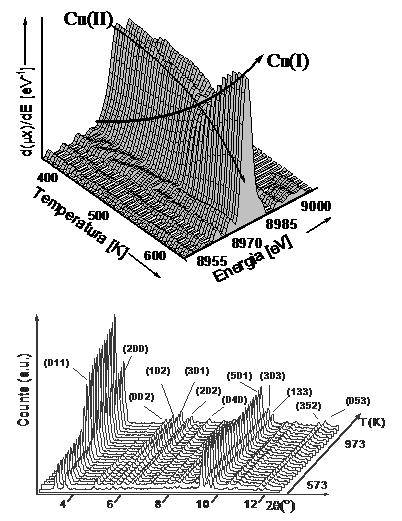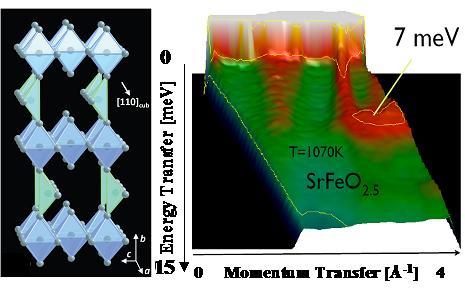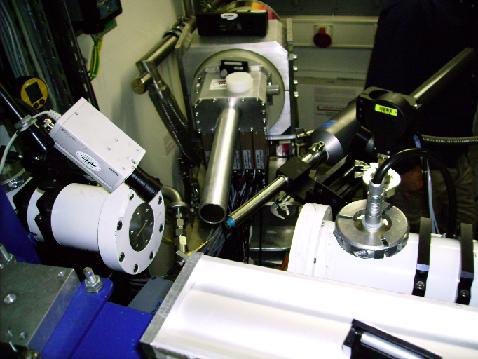EXPERIMENTS AT LARGE-SCALE FACILITIES
NIS users have access to several Large Scale facilities. Both X-ray and neutron sources have been exploited. Access to synchrotrons and neutron sources is regulated by acceptance of a research proposal by international review committees. Synchrotrons where NIS users have usually access:
- ESRF, Grenoble (F) http://www.esrf.eu/
- SLS, Villigen (CH) http://sls.web.psi.ch/view.php/about/index.html
- Elettra, Trieste (I) http://www.elettra.trieste.it/
Type of experiments
-
XAS (X-ray Absortpion Spectroscopy), in both XANES and EXAFS region. The technique allows to obtain information on the local structure around the absorbing atom (coordination numbers, distances, heterogeneity, oxidation state, etc.) and can be applied on both crystalline and amorphous materials. It is possible to measure highly diluted samples. In the different beamlines of the different light sources K-edges ranging from B (0.2 keV) to Pr (42 keV) have been spanned until now.
-
High resolution XRPD (X-ray powder diffraction). With respect to standard laboratory measurements, syncrotron radiation XRPD benefits of the high angular resolution (due to the small divergency of the beam) that allows to separate reflections very close in d-spacing. Moreover, the selection of continuous wavelenghts ranging from ~4 down to 0.3 Å implies: to minimize the sample absorption, or to become atomically selective by tuning the l across a specific atomic absorption edge, or to reach very low d-spacing. This allows to perform accurate Rietveld refinement on very complex systems like zeolites or MOFs.
-
Single crystal XRD. High brilliant focused X-ray beams allows to measure single crystals down to the micrometer dimension limits, even on complex systems like zeolite or MOFs. Combination between single crystal XRD and energy resolved X-ray fluorescence (XRF) allows to determine the phase in a diffraction experiment, also known as X-ray standing waves technique.
-
Time-resolved XAS and XRPD. On specific beamlines time-resolved experiments can be performed down to millisecond scale for XAS measurements (ESRF, ID24), and down to second scale for XRPD experiments (ESRF, BM8 Gilda, translating image plate).
-
Space resolved XAS, XRD and XRF mapping. On specific beamlines (ESRF, ID22, ID18; SLS, MicroXAS) XAS, XRD and chemical analysis by XRF detection can be performed down to the micrometer range.
-
Small Angle XRD. The medium range order in liquid or amorphous systems can be probed by small angle XRD measurements. The high X-ray flux allows to improve laboratory experiments in terms of time resolution and sample-detector distance, i.e. pushing down the limit of the smallest angle measurable (larger d-spacing value) of more than one order of magnitude. This can be done on specific beamlines like ID02 and BM26B at the ESRF.
-
Pump and probe experiments. The time structure of the light emitted by synchrotrons (bunches having a width of about 1 ns) allows, with the use of appropriate choppers, to perform pump and probe experiments. The modification of the local environment of a chromophore, induced by laser excitation, can be probed as a function of the delay from excitation down to 100 ps scale. Two specific beamlines allow this kind of experiments using either XRD (ESRF, ID09B) or XAS (SLS, MicroXAS) techniques.
All these measurements can be performed in in situ conditions. Ad hoc cells and experimental set-ups allowing measurements in controlled atmosphere and in a variable range of temperature and pressure are at disposal of NIS users.

Examples of time-resolved XAS and XRPD data collection.
Neutron sources where NIS users have usually access:
- ILL, Grenoble (F) http://www.ill.eu/
- ISIS, Didcot (UK) http://www.isis.rl.ac.uk/
- SINQ, Villigen (CH) http://sinq.web.psi.ch/
- FRM-II, München (D) http://www.frm2.tum.de/
Type of experiments
-
Single crystal or powder neutron diffraction. With respect to XRD, neutron diffraction is characterized by atomic scattering factors that do not scale with the atomic number Z and that are almost constant in the whole 2q region. This allows to locate light atoms in absorbing matrices, like O in high Z oxides, or hydrogen in deuterated systems. More complete information can be obtained by joint refinements of data sets collected on samples prepared with different isotopes. The accuracy of patterns in the high 2q region results in much more precise information on the low d-spacings, allowing to better discriminate between different atoms located very closely in the unit cell.
-
Inelastic neutron scattering (INS). Reports information on the vibrational modes of solids, liquids and molecules. With respect to the standard IR and Raman techniques, it is not subjected by the optical selection rules, allowing the detection of all modes. INS implies both a energy and momentum transfer, thus allowing to map the whole Brillouin zone of solids (only the G point is probed by Raman).

INS experiment conducted on a oxygen deficient perovskite, proving that the oxygen conduction mechanism is phonon assisted.

 EXAFS experiment in challenge conditions: the sample is closed in controlled armosphere inside sealed capillaries; the temperature can be tuned in the 100 – 300 K range with a N2 cryostream; EXAFS signal is collected in both fluorescence and transmission mode.
EXAFS experiment in challenge conditions: the sample is closed in controlled armosphere inside sealed capillaries; the temperature can be tuned in the 100 – 300 K range with a N2 cryostream; EXAFS signal is collected in both fluorescence and transmission mode.